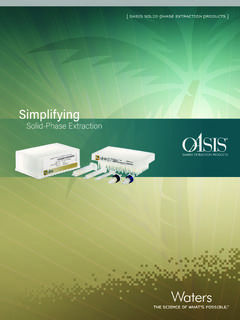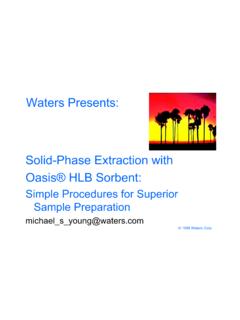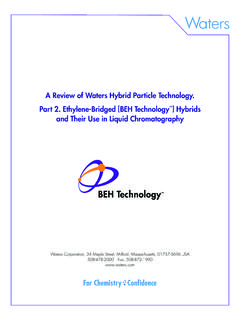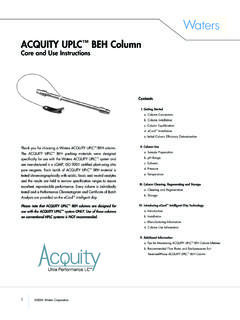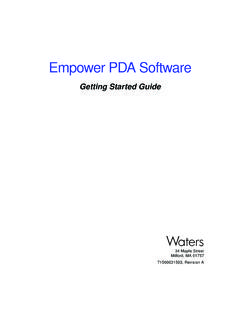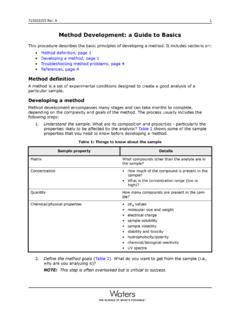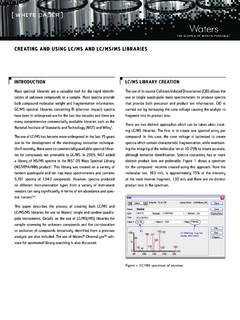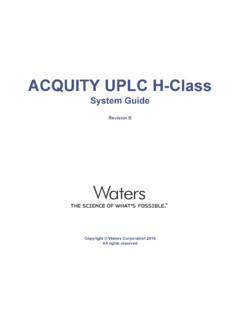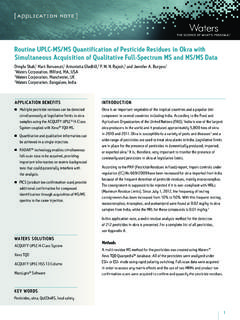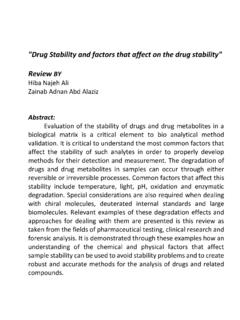Transcription of Symmetry Columns - Waters Corporation
1 [ CARE AND USE MANUAL ]1 CONTENTSI. INTRODUCTIONII. GETTING STARTED a. Column Installation b. Column Equilibration c. Initial Column Efficiency Determination III. COLUMN USE a. Guard Columns b. Sample Preparation c. pH Range d. Solvents e. Pressure f. TemperatureIV. SCALING UP/DOWN ISOCRATIC METHODSV. TROUBLESHOOTINGVI. COLUMN CLEANING, REGENERATING AND STORAGE a. Cleaning and Regenerating b. StorageVII. CONNECTING THE COLUMN TO THE HPLC a. Column Connectors and System Tubing Considerations b. Band Spreading Minimization c. Cartridge Installation d. Measuring System Bandspreading Volume & System Variance e. Measuring System VolumeVIII. ADDITIONAL INFORMATION a. Use of Narrow-Bore ( mm ) Columns b. Impact of Bandspreading Volume on mm Column Performance c. Non-Optimized vs. Optimized LC-MS/MS System: System Modification Recommendations d.
2 Waters Small Particle Size ( m) Columns Fast ChromatographyI. INTRODUCTIONT hank you for choosing a Symmetry Column. Symmetry Columns continue to set the standard of performance for reproducibility. As today s chemists establish new analytical methods for the latest pharmaceutical and biopharmaceutical products, the selection of a reproducible HPLC column is essential. The selected column needs to provide the same chromatographic results over the life of the new drug product. The excellent reproducibility of Symmetry , SymmetryShield and Symmetry300 Columns is a result of our commitment to maintaining the tightest specifications in the HPLC column ColumnsPhysical CharacteristicsPackingChemistryParticle SizeParticle ShapePore SizeCarbon LoadEnd- , 5 , 5 mSphericalSpherical100 100 19%12%YesYesSymmetryPrepC18C87 m7 mSphericalSpherical100 100 19%12% , 5, 7 , 5, 7 mSphericalSpherical100 100 17%15% , 5 , 5 mSphericalSpherical300 300 Columns [ CARE AND USE MANUAL ]II.
3 GETTING STARTEDEach Symmetry Column comes with Certificate of Analysis and a Performance Test Chromatogram. The Certificate of Analysis is specific to each batch of packing material contained in the Symmetry Column and includes the gel batch number, analysis of unbonded particles, analysis of bonded particles, and chromatographic results and conditions. The Performance Test Chromatogram is specific to each individual column and contains the information: gel batch number, column serial number, USP plate count, USP tailing factor, capacity factor, and chromatographic conditions. These data should be stored for future Column InstallationNote: The flow rates given in the procedure below are for a typical mm column. Scale the flow rate up or down accordingly based upon the column , length, particle size, and backpressure of the Symmetry column being installed. See Scaling Up/Down Isocratic Separations for calculating flow rates when changing column and/or length.
4 See Connecting the Column to the HPLC for a more detailed discussion on HPLC Purge the pumping system of any buffer-containing mobile phases and connect the inlet end of the column to the injector Flush column with 100% organic mobile phase (methanol or acetonitrile) by setting the pump flow rate to mL/min and increase the flow rate to 1 mL/min over 5 When the mobile phase is flowing freely from the column outlet, stop the flow and attach the column outlet to the detector. This prevents entry of air into the detection system and gives more rapid baseline Gradually increase the flow rate as described in step Once a steady backpressure and baseline have been achieved, proceed to the next Column EquilibrationSymmetry Columns are shipped in 100% acetonitrile. It is important to ensure mobile phase compatibility before changing to a different mobile phase system. Equilibrate the column with a minimum of 10 column volumes of the mobile phase to be used (refer to Table 1 for a listing of empty column volumes).
5 To avoid precipitating out mobile phase buffers on your column or in your system, flush the column with five column volumes of a water /organic solvent mixture, using the same or lower solvent content as in the desired buffered mobile phase. (For example, flush the column and HPLC system with 60% methanol in water prior to introducing 60% methanol/40% buffer mobile phase.)Note: If mobile phase additives are present in low concentrations ( , ion-pairing reagents), 100 to 200 column volumes may be required for complete equilibration. In addition, mobile phases that contain formate ( , ammonium formate, formic acid, etc.) may also require longer initial column equilibration Initial Column Efficiency Determination1. Perform an efficiency test on the column before using it. Waters recommends using a suitable solute mixture, as found in the Performance Test Chromatogram , to analyze the column upon Determine the number of theoretical plates (N) and use this value for periodic Repeat the test at predetermined intervals to track column performance over time.
6 Slight variations may be obtained on two different HPLC systems due to the quality of the connections, operating environment, system electronics, reagent quality, column condition and operator 1. Empty Column Volumes in mL (multiply by 10 for flush solvent volumes)ColumnColumn internal diameter (mm) 8193020 mm 30 mm 8 50 250 mm 70 3 Symmetry Columns [ CARE AND USE MANUAL ]III. COLUMN USETo ensure the continued high performance of Symmetry Columns , follow these guidelines:a. Guard ColumnsUse a Waters guard column of matching chemistry and particle size between the injector and main column. It is important to use a high performance matching guard column to protect the main column while not compromising or changing the analytical resolution. Guard Columns need to be replaced at regular intervals as determined by sample contamination. When system backpressure steadily increases above a set pressure limit, it is usually an indication that the guard column should be replaced.
7 A sudden appearance of split peaks is also indicative of a need to replace the guard Sample Preparation1. Sample impurities often contribute to column contamination. One option to avoid this is to use Oasis solid -phase extraction cartridges/ Columns or Sep-Pak cartridges of the appropriate chemistry to clean up the sample before analysis. See www. It is preferable to prepare the sample in the operating mobile phase or a mobile phase that is weaker (less organic modifier) than the mobile phase for the best peak shape and If the sample is not dissolved in the mobile phase, ensure that the sample, solvent and mobile phases are miscible in order to avoid sample and/or buffer precipitation. Filter sample with m membranes to remove particulates. If the sample is dissolved in a solvent that contains an organic modifier ( , acetonitrile, methanol, etc.) ensure that the membrane material does not dissolve in the solvent. Contact the membrane manufacturer with solvent compatibility questions.
8 Alternatively, centrifugation for 20 minutes at 8,000 rpm, followed by the transfer of the supernatant liquid to an appropriate vial, could be pH RangeThe recommended operating pH range for Symmetry Columns is 2 to 8. A listing of commonly used buffers and additives is given in Table 2. Additionally, the column lifetime will vary depending upon the operating temperature, the type and concentration of buffer used. For example, the use of phosphate buffer at pH 8 in combination with elevated temperatures will lead to shorter column 2: Buffer Recommendations for Using Symmetry Columns from pH 2 to 8 Additive or BufferpKaBuffer range ( 1 pH unit)VolatilityUsed for Mass Spec?CommentsFormic buffering obtained when used with Ammonium Formate salt. Used in buffering obtained when used with Ammonium Acetate salt. Used in Formate (NH4 COOH) in the 1-10 mM : sodium or potassium salts are not Acid (TFA) used in LC-MS, due to signal suppression, it is generally recommended to use TFA at concentrations < Acetate (NH4CH2 COOH) in the 1-10 mM : sodium or potassium salts are not low pH buffer, good UV 27.
9 PH 7, reduce temperature/concentration and use guard column to maximize Columns [ CARE AND USE MANUAL ]d. SolventsTo maintain maximum column performance, use high quality chromatography grade solvents. Filter all aqueous buffers prior to use. Pall Gelman Laboratory Acrodisc filters are recommended. Solvents containing suspended particulate materials will generally clog the outside surface of the inlet distribution frit of the column. This will result in higher operating pressure and poorer performance. Degas all solvents thoroughly before use to prevent bubble formation in the pump and detector. The use of an on-line degassing unit is also recommended. This is especially important when running low pressure gradients since bubble formation can occur as a result of aqueous and organic solvent mixing during the PressureSymmetry Columns can tolerate pressures of up to 6,000 psi (400 bar or 40 Mpa) although pressures greater than 4,000 5,000 psi should be avoided in order to maximize column and system TemperatureTemperatures between 20 C 45 C are recommended for operating Symmetry Columns in order to enhance selectivity, lower solvent viscosity and increase mass transfer rates.
10 However, any temperature above ambient will have a negative effect on lifetime which will vary depending on the pH and buffer conditions SCALING UP/DOWN ISOCRATIC METHODSThe following formulas will allow scale up or scale down, while maintaining the same linear velocity, and provide new sample loading values: If column and length are altered: F2 = F1(r2/r1)2 or Injection volume1 = Injection volume2 (r2/r1)2(L2/L1)Where: r = Radius of the column, in mm F = Flow rate, in mL/min L = Length of column, in mm 1 = Original, or reference column 2 = New columnV. TROUBLESHOOTINGC hanges in retention time, resolution, or backpressure are often due to column contamination. See Column Cleaning, Regenerating and Storage. Information on column troubleshooting problems may be found in the current Waters Chromatography Columns and Supplies Catalog. You can also download a copy of the HPLC Troubleshooting Guide, Literature Code COLUMN CLEANING, REGENERATING AND STORAGEa.
